Drought conditions have improved across Puerto Rico, but have deteriorated across the U.S Virgin Islands.
Key Points
- Puerto Rico Conditions: Beneficial rains have been observed across the southern slopes with significant drought improvement noticed. Only 4% of the island is considered to be in drought at this time, with 31% Abnormally Dry (D0). These conditions represent significant improvement since early April.
- U.S. Virgin Islands Conditions: Drought continues to worsen on all three islands, despite the fact that May is typically the wettest month of the year outside the September–November wet season. That was certainly not the case this year, as both short-term and long-term drought plague St. Croix. Rohlsen Airport in St. Croix received only 0.34 inch of rain in May, or about 9% of normal. This is the 3rd lowest total in 64 years of data. The year to date total of 5.12 inches through May 31 is the 2nd lowest on record, and less than 50% of normal. Only 1977 was drier. Hence, the Extreme (D3) Drought conditions, which by definition occur once every 20 to 50 years. St. Thomas was only marginally better, with a year to date total of 6.36 inches of rain, or the 6th driest such period in 55 years of data. This is also the lowest YTD total through May 31 since 2008.
- Puerto Rico Impacts: Low soil moisture and below-normal streamflows continue to prevail across portions of eastern Puerto Rico, as well as areas across the southwest and northwest coast of the island. Above-normal temperatures with heat indices exceeding 100°F each day have prevailed islandwide for much of May and June.
- U.S. Virgin Islands Impacts: Lack of rainfall, high winds, and high temperatures have reduced the moisture in the soil, and ponds are drying out. Farmers and ranchers have reported distress in vegetation, a decrease in egg production, and that some animals succumbed to a combination of heat, lack of water, and access to grazing.
- Looking Ahead: Climatologically speaking, rainfall totals in June and July are usually less than in May, before the main wet season begins in August. Precipitation from August to November will be critical as to whether the drought can be broken.
- For weather information specific to your area, please monitor products issued by the National Weather Service in San Juan.
U.S. Drought Monitor map for Puerto Rico, as of June 6, 2023. The U.S. Drought Monitor is updated each Thursday to show the location and intensity of drought across the country.
The map uses 5 classifications: Abnormally Dry (D0), showing areas that may be going into or are coming out of drought, and four levels of drought (D1–D4).
U.S. Drought Monitor map for the U.S. Virgin Islands, as of June 6, 2023. The U.S. Drought Monitor is updated each Thursday to show the location and intensity of drought across the country.
The map uses 5 classifications: Abnormally Dry (D0), showing areas that may be going into or are coming out of drought, and four levels of drought (D1–D4).
U.S. Drought Monitor
D0 - Abnormally Dry
Abnormally Dry (D0) indicates a region that is going into or coming out of drought, according to the U.S. Drought Monitor. View typical impacts by state.
D1 – Moderate Drought
Moderate Drought (D1) is the first of four drought categories (D1–D4), according to the U.S. Drought Monitor. View typical impacts by state.
D2 – Severe Drought
Severe Drought (D2) is the second of four drought categories (D1–D4), according to the U.S. Drought Monitor. View typical impacts by state.
D3 – Extreme Drought
Extreme Drought (D3) is the third of four drought categories (D1–D4), according to the U.S. Drought Monitor. View typical impacts by state.
D4 – Exceptional Drought
Exceptional Drought (D4) is the most intense drought category, according to the U.S. Drought Monitor. View typical impacts by state.
U.S. Drought Monitor Categories
Abnormally Dry (D0)
Abnormally Dry (D0) indicates a region that is going into or coming out of drought. View typical impacts by state.
Moderate Drought (D1)
Moderate Drought (D1) is the first of four drought categories (D1–D4), according to the U.S. Drought Monitor. View typical impacts by state.
Severe Drought (D2)
Severe Drought (D2) is the second of four drought categories (D1–D4), according to the U.S. Drought Monitor. View typical impacts by state.
Extreme Drought (D3)
Extreme Drought (D3) is the third of four drought categories (D1–D4), according to the U.S. Drought Monitor. View typical impacts by state.
Exceptional Drought (D4)
Exceptional Drought (D4) is the most intense drought category, according to the U.S. Drought Monitor. View typical impacts by state.
U.S. Drought Monitor map for Puerto Rico, as of June 6, 2023. The U.S. Drought Monitor is updated each Thursday to show the location and intensity of drought across the country.
The map uses 5 classifications: Abnormally Dry (D0), showing areas that may be going into or are coming out of drought, and four levels of drought (D1–D4).
U.S. Drought Monitor map for the U.S. Virgin Islands, as of June 6, 2023. The U.S. Drought Monitor is updated each Thursday to show the location and intensity of drought across the country.
The map uses 5 classifications: Abnormally Dry (D0), showing areas that may be going into or are coming out of drought, and four levels of drought (D1–D4).
The U.S. Drought Monitor is updated weekly on Thursday morning, with data valid through that Tuesday at 7 am Eastern.
The U.S. Drought Monitor is updated weekly on Thursday morning, with data valid through that Tuesday at 7 am Eastern.
Overview
Current Conditions: Drought conditions have improved considerably across Puerto Rico since early April, with only 4% of the island in Moderate Drought (D1) at this time, compared to 45% on the April 6, 2023 U.S. Drought Monitor issuance. A small area of D1 remains along the northwest coast. In the U.S. Virgin Islands, conditions continue to persist and deteriorate, with Moderate Drought (D1) on Saint John, Severe Drought (D2) on Saint Thomas, and Extreme Drought (D3) on Saint Croix.
Looking Ahead: Rainfall totals in June and July are usually less than in May, before the late summer wet-season ramp-up begins in August. Precipitation from August to November will be critical for breaking the drought, since these are the wettest 4 months of the year. This will also be influenced by tropical systems, where the NOAA Atlantic Basin Tropical Cyclone Outlook for 2023 calls for near-normal hurricane activity being the most likely outcome.
Current Conditions
Drought Conditions
- Puerto Rico: Around 30% of Puerto Rico is currently considered dry or in drought according to the U.S. Drought Monitor, with 4% categorized as Moderate Drought (D1) and 27% categorized as Abnormally Dry (D0).
- U.S. Virgin Islands: According to the U.S. Drought Monitor, Moderate Drought (D1) is observed across Saint John, Severe Drought (D2) across Saint Thomas, and Extreme Drought (D3) across Saint Croix. May is usually the wettest month of the year outside of the September–November wet season. That was certainly not the case this year, as both short-term and long-term drought plague St. Croix. Rohlsen Airport in St. Croix received only 0.34 inch of rain in May, or about 9% of normal. That is the 3rd lowest total in 64 years of data. The year to date total of 5.12 inches through May 31 is the 2nd lowest on record, and less than 50% of normal. Only 1977 was drier. Hence, the extreme (D3) drought conditions, which by definition occur once every 20 to 50 years. St. Thomas was only marginally better, with a year to date total of 6.36 inches of rain, or the 6th driest such period in 55 years of data. This is also the lowest YTD total through May 31 since 2008. This marks the 6th consecutive May in a row with below-normal rainfall at St. Croix. This sudden dryness in May is a large contributor to St. Croix being in extreme drought now in the month of June for 2 consecutive years.
Sector Impacts
Agricultural Conditions
- Puerto Rico: In Juana Díaz, though dry conditions are visibly present, there are signs that rain has been falling throughout the region, and some pastures of the area remain green. Moist soil has been found in Coamo Municipality, and there has been more precipitation in the area compared to the first months of 2023. A farmer in the mountainous region of Caguas shared that the soil has been dry since the beginning of the year, crops are suffering damage due to lack of water availability, and the producer is taking advantage of the dry conditions to mechanically remove non-desirable weeds. A farmer in Cidra indicates that there was little to no precipitation until mid-May. Even though some precipitation was observed through May, the first week of June has been dry and hot, which has affected the health and performance of workers in the field.
- St. Thomas: Farmers on St. Thomas are reporting daily hot, dry weather, which is causing ponds to dry out. Soils are losing their moisture due to the high temperatures and high winds, which have been reported at or above 20 mph daily. Due to concerns over extreme heat of more than 84 degrees daily and humidity at or above 75%, many are doing what they can to plan and prepare irrigation and water efficiency tools to better manage water as part of a longer-term mitigation and conservation plan. Many are considering the use of permaculture and/or tree planting to create shade areas to aid them with soil moisture. Specialty and row crop farmers are working to manage water usage by installing gravity fed irrigation tools and are moving to drought-tolerant crops to keep production up while still conserving water. Many are not planting due to drought and are working on land management practices to aid them during non-drought periods. Livestock farmers are rotating livestock.
- St. John: Row and specialty crop farmers on St. John are reporting that they have little to no rain and they are now in the dry season. The combination of high winds and high temperatures are reducing the moisture in the soil. Farmers are preparing for a long, hot season. Most are currently focusing on micro greens, fruit trees, and quick crops to keep production levels up while rotating them. Most farmers are also preparing land for the wet season where they hope to increase production and make up for lost sales that were impacted during this dry season.
- St. Croix: Farmers have seen sporadic rain; however, these intermittent showers are not penetrating the soil due to evaporation from high winds. Livestock farmers are working to plan for feed shortages later this summer due to a lack of grass during the hotter months. The USVI Department of Agriculture (VIDA) is currently buying and storing hay. Ranchers are looking to drought mitigation strategies to plan for vegetation distress and land management. Poultry farmers are now indicating that egg production has been reduced up to 50% due to the heat. Poultry farmers also report they are concerned that chickens are not eating grain. Farmers who have poultry, including both broilers and/or egg production, have smaller numbers because they have less water and they must collect water in containers or use cistern water. Lastly, livestock farmers are reporting dead animals due to heat and a lack of access to grazing lands. More than 20 horses, livestock, and even wild deer have succumbed due to the heat and lack of water. VIDA on St. Croix reported that they provided more than 1,028,370 gallons of water to farmers in April, and in May they supplied 1,588,170 gallons of water to farmers.
- Assistance for USVI farmers and ranchers: According to the U.S. Department of Agriculture, St. Croix has already qualified for a 2023 secretarial drought disaster declaration, based on the U.S. Drought Monitor depiction. Similarly, livestock producers on St. Croix have qualified for direct assistance through the USDM-driven Livestock Forage Program. LFP assistance begins when Severe Drought (D2) lasts 8 weeks or more, with payments tripling when the Extreme Drought (D3) threshold is reached.
Rainfall Trends
Short-term rainfall deficits are observed across northwest Puerto Rico, as well as portions of the eastern interior. Rainfall deficits across these areas are ranging between 2 to 6 inches with isolated amounts of up to 8 inches (Figure 1).
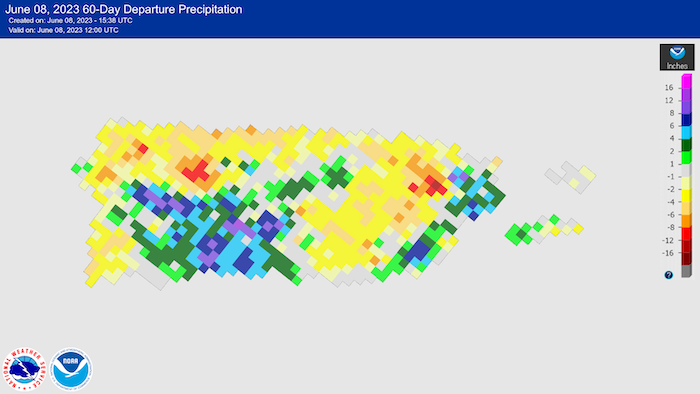
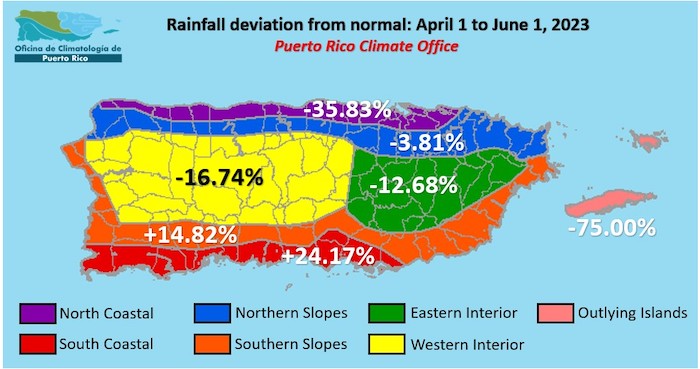
Soil Moisture Conditions in Puerto Rico
The latest soil moisture data from the Puerto Rico Agricultural Water Management (PRAGWATER) indicates dry soil conditions persisting across portions of eastern Puerto Rico and areas of the southwest and northwest coast (Figures 3 and 4).
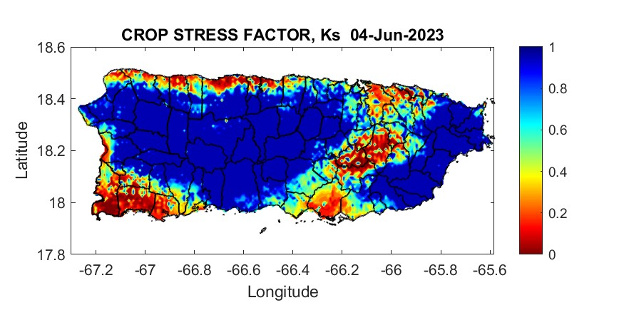
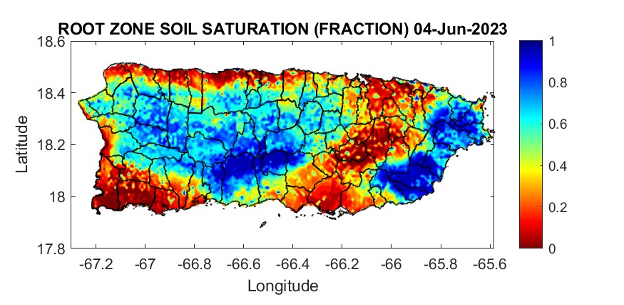
Streamflow and Reservoir Conditions in Puerto Rico
The real-time 28-day average streamflow from the U.S. Geological Survey (USGS) river gauge network (Figure 5) indicates streamflows across eastern Puerto Rico, as well as a few spots across northwestern Puerto Rico, are running below normal. Reservoir levels continued to recede with Guajataca under close observation. Groundwater levels at selected observation wells in the south coast of Puerto Rico are near optimal levels, except for Constancia 3 at Ponce, which is being monitored.
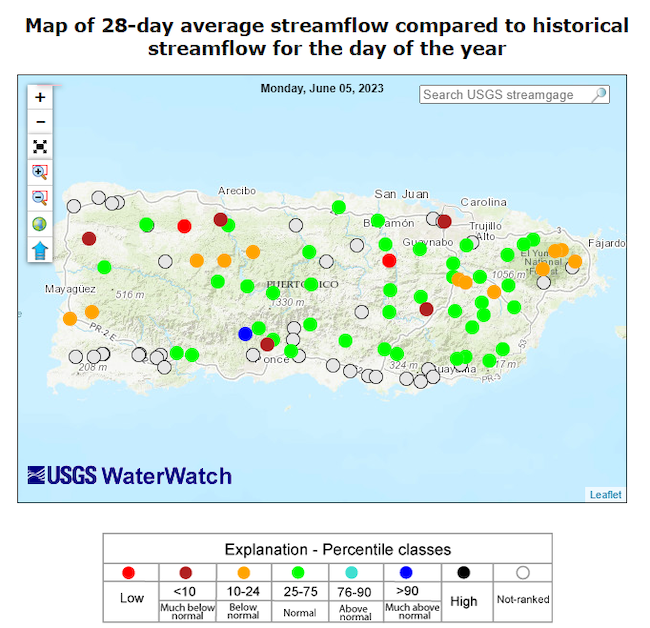
Outlooks
Rainfall Outlook
Climatologically speaking, rainfall totals in June and July are usually less than in May, before the late summer ramp-up in August. Precipitation from August to November will be critical for breaking the drought.
It is worth noting that the NOAA Atlantic Basin Tropical Cyclone Outlook for 2023 calls for near-normal hurricane activity being the most likely outcome. On average, the Atlantic Basin sees 14 named storms per year, with 7 hurricanes, and 3 major hurricanes.
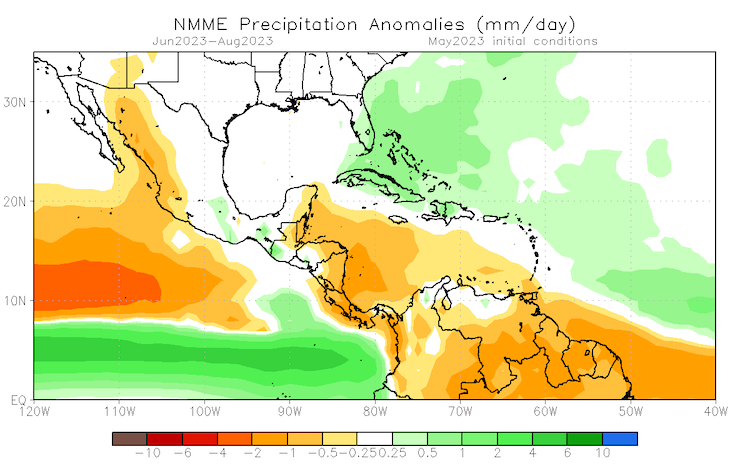
For More Information
- National Weather Service (NWS) Weather Forecast Office – San Juan: Climate and Drought Information
- NWS Drought Information Statements for Puerto Rico and the U.S. Caribbean
- Drought.gov:
- Caribbean Drought Bulletins. Caribbean Regional Climate Center, Caribbean Institute for Meteorology and Hydrology (CIMH), Barbados
- U.S. Department of Agriculture (USDA) Caribbean Climate Hub drought and disaster assistance resources for tropical forestry and agriculture
Prepared By
Odalys Martinez
National Weather Service Weather Forecast Office – San Juan
Héctor J. Jiménez
Office of Climatology, University of Puerto Rico
Meredith Muth
NOAA/National Integrated Drought Information System (NIDIS)
Victor Murphy
National Weather Service Southern Region
Christina Chanes
University of Virgin Islands
Eva Holupchinski, Silmarie Crespo Vélez, and Nora Álvarez-Berríos
USDA Caribbean Climate Hub, USFS International Institute of Tropical Forestry
Brad Rippey
USDA Office of the Chief Economist
Timothy Dalrymple
USGS Caribbean - Florida Water Science Center (CFWSC)
Puerto Rico Reporting Input: Thanks to the Agricultural Extension Service, College of Agricultural Sciences, University of Puerto Rico-Mayaguez. Special thanks to Dr. Luis Alexis Rodríguez-Cruz, Dr. Diana Guzmán Colón, Agronomists Merari Torres Amaro and Warys Zayas, and farmer from the Caguas region Juan Vélez for their comments and inputs on their regions drought conditions.
USVI Reporting Input: Several individuals contributed to this report and we are acknowledging the following for their support including the farming community across the USVI, UVI faculty, staff and collaborators of the UVI School of Agriculture, UVI Physics Program, UVI Etelman Observatory, UVI Agricultural Experiment Station, VI Department of Agriculture, as well as the USDA Office Chief Economist, National Parks Service in St. Croix, VI Department of Planning and Natural Resources, USDA Farm Service Agency, Coral Bay Community Council and the many volunteer drought reporters and farmers from across the territory.
About This Report
This drought update is issued in partnership between the National Integrated Drought Information System (NIDIS), National Oceanic and Atmospheric Administration (NOAA) National Weather Service, the U.S. Department of Agriculture (USDA), and the University of the Virgin Islands. The purpose of the update is to communicate a potential area of concern for drought expansion and/or development within Puerto Rico and the U.S. Virgin Islands based on recent conditions and the upcoming three-month forecast.
NIDIS and its partners will issue these updates every two months. Subscribe for these U.S. Caribbean drought updates here.







